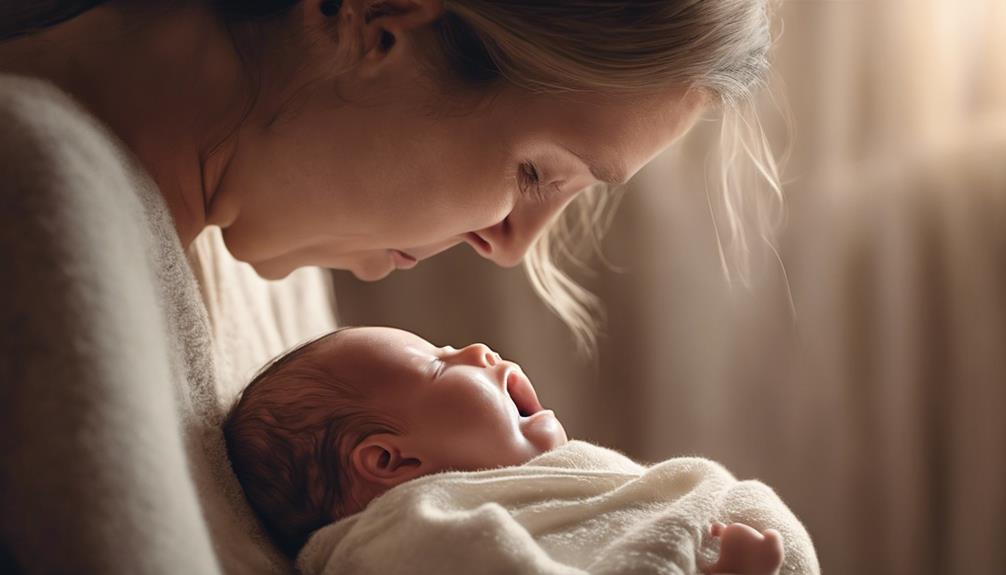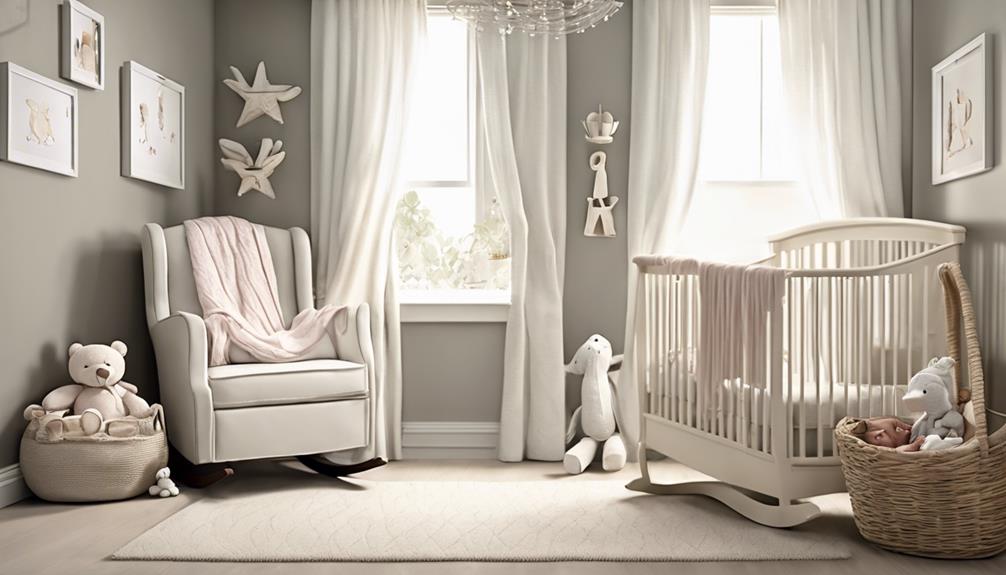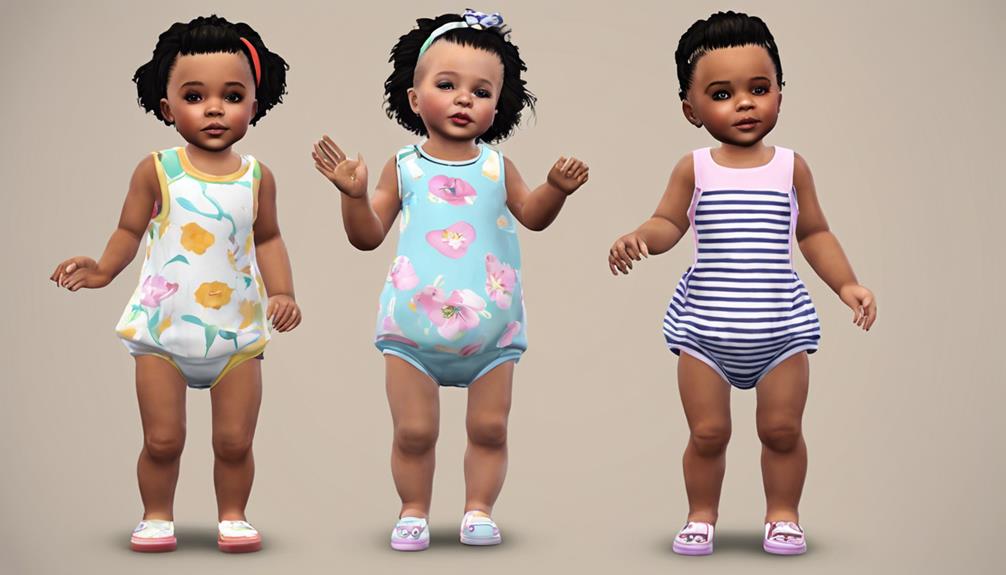When it comes to helping your newborn get rid of hiccups, there are seven effective strategies you can use. From adjusting feeding methods to gentle patting techniques, each approach is important in calming your baby.
However, there is one often-overlooked technique that might just surprise you with its simplicity and effectiveness. By incorporating this method into your routine, you can provide your baby with the relief they need in a natural and comforting way.
Key Takeaways
- Hold baby upright after feeding to prevent hiccups caused by stomach pressure
- Burp baby strategically to release trapped air and reduce discomfort
- Utilize skin-to-skin contact to regulate breathing and soothe hiccups
- Consider using pacifiers and comfort items to mimic feeding motion and promote relaxation
Positioning Techniques
To help alleviate your baby's hiccups, consider utilizing various positioning techniques that can aid in releasing trapped air and promoting better digestion. Holding your baby in an upright position after feeding can help prevent stomach pressure, reducing the likelihood of hiccups. Placing your little one on your shoulder or in a slightly upright position allows gravity to assist in moving air bubbles, alleviating hiccups effectively.
Additionally, utilizing a baby carrier or holding your baby vertically against your chest promotes burping and gas release, minimizing hiccups. For nighttime relief, elevating the head of your baby's crib slightly can aid in reducing hiccups by preventing acid reflux and supporting better digestion. By incorporating these simple yet effective positioning techniques, you can help your baby find comfort and relief from hiccups while also promoting healthy digestion.
Feeding Adjustments

When feeding your newborn, make sure they're positioned upright to minimize hiccups caused by swallowing air. To further assist your baby in reducing hiccups, consider the following feeding adjustments:
- Use a slow-flow nipple: Opting for a slow-flow nipple can help regulate the milk flow, preventing your baby from gulping down milk too quickly and swallowing excess air.
- Try pace feedings: Implementing pace feedings encourages a slower feeding rhythm, allowing your newborn to feed at a more comfortable pace and reducing the chances of hiccups due to rapid ingestion.
- Take breaks to burp: Pausing during feedings to burp your baby can help release trapped air, easing any discomfort and minimizing the likelihood of hiccups caused by trapped air bubbles.
Burping Methods

When it comes to helping your newborn with hiccups, effective burping techniques are key. Remember to burp bottle-fed babies every 2–3 ounces and breastfed babies when switching sides.
Try the gentle patting method to release any trapped air and minimize the chances of hiccups occurring.
Effective Burping Techniques
Effective burping techniques play an important role in helping newborns expel trapped air and prevent hiccups after feeding. Here are some techniques to guarantee successful burping:
- For Bottle-fed Babies: Burp every 2–3 ounces to release excess air intake.
- For Breastfed Babies: Burp when switching between breasts to reduce air swallowing.
- General Technique: Hold your baby against your chest or over your shoulder and gently pat or rub their back to encourage burping.
Timing for Burping
To optimize the effectiveness of burping, timing your burping sessions strategically can greatly reduce the likelihood of hiccups in newborns. For bottle-fed babies, burping every 2–3 ounces during feedings helps release trapped air and prevent hiccups. Breastfed infants should be burped when switching between breasts to minimize air intake and decrease the chances of hiccups. Proper burping methods are essential in relieving stomach discomfort and ensuring newborns are comfortable after feedings. By burping your baby at the right times, you can help alleviate any trapped air, reduce the risk of hiccups, and promote a more pleasant feeding experience. Check the table below for a quick guide on timing your burping sessions effectively.
| Bottle-fed Babies | Breastfed Babies | General Tips |
|---|---|---|
| Every 2-3 ounces | When switching sides | Burp during and after feedings |
Gentle Patting Method
If your newborn is experiencing hiccups, one effective method to help release trapped air is through gentle patting on their back, a simple yet beneficial technique in alleviating discomfort. This method aids in relaxing the diaphragm and expelling excess air from the stomach, providing relief for your little one.
Here's how you can use the gentle patting method to help your newborn get rid of hiccups:
- Place your baby on your shoulder or lap in an upright position.
- Gently pat your baby's back in a rhythmic motion to help release trapped air.
- Continue patting until your newborn burps, relieving the air causing the hiccups.
Pacifier Use

When your newborn has hiccups, using a pacifier can be a simple way to help ease their discomfort. The sucking motion can relax their diaphragm and potentially bring relief.
Make sure to choose a pacifier that's the right size for your baby's age to guarantee safe and effective use.
Pacifier Benefits Explained
Wondering how pacifiers can benefit newborns experiencing hiccups? Pacifiers play an essential role in soothing your little one and helping relieve those pesky hiccups. Here's why pacifiers are advantageous:
- Relaxing the Diaphragm: Pacifiers can help relax the diaphragm in newborns, potentially stopping hiccups.
- Mimicking Feeding: Sucking on a pacifier mimics the motion of breastfeeding or bottle feeding, aiding in soothing hiccups.
- Regulating Breathing: The sucking action of a pacifier may help regulate breathing patterns, contributing to hiccup relief in newborns.
Using a pacifier provides comfort, distraction, and a familiar action that can help your baby focus less on hiccups, promoting a sense of calmness and relief.
Proper Pacifier Size
To guarantee ideal comfort and effectiveness in soothing your newborn's hiccups, selecting a pacifier that matches your baby's mouth size is essential. The correct size pacifier can relax the diaphragm and potentially stop hiccups, providing optimal comfort for your little one. Using a pacifier that is too small or too large may not help with hiccups and could be uncomfortable. Pacifiers are available in various sizes tailored to your baby's age and mouth development. Consulting with your pediatrician or healthcare provider can assist you in choosing the right size pacifier for your newborn. Ensuring the proper fit of the pacifier is crucial for your baby's comfort and soothing experience.
| Proper Pacifier Size | ||
|---|---|---|
| Ensure Comfort | Match Mouth Size | Consult Professional |
| Relax Diaphragm | Stop Hiccups | Optimal Soothing |
| Tailored Development | Pediatrician Guidance | Healthcare Provider |
Pacifier Safety Tips
For enhanced safety and comfort, consider these essential tips for using pacifiers with your newborn:
- Choose Safe Materials: Opt for pacifiers made of safe materials to prevent choking risks and guarantee your baby's well-being.
- Limit Use to Sleep Times: Restrict pacifier use to sleep times to decrease the chances of dependency and potential dental issues.
- Maintain Hygiene: Regularly replace pacifiers to uphold hygiene standards and maximize their effectiveness in soothing hiccups.
Following these guidelines won't only help in soothing your newborn's hiccups by relaxing the diaphragm but also provide the comfort and safety necessary for your little one's well-being.
Gentle Patting

Gentle patting on your newborn's back can be a soothing and effective way to help alleviate hiccups caused by trapped air bubbles.
When you softly pat your baby in an upward motion, it can aid in releasing excess gas and easing diaphragm spasms, providing comfort to your little one.
Importance in this gentle patting technique can assist in stopping hiccups more quickly.
It's vital to approach the patting with care, ensuring it's done in a soothing manner to prevent any discomfort to your newborn.
Skin-to-Skin Contact

Engage in comforting skin-to-skin contact with your newborn to help regulate their breathing and heart rate, potentially aiding in stopping hiccups. This intimate practice not only fosters bonding but also provides a range of benefits that can help alleviate your baby's discomfort:
- Regulate Breathing and Heart Rate: The closeness of skin-to-skin contact can assist in stabilizing your newborn's breathing and heart rate, creating a calming environment that may help halt hiccups.
- Promote Relaxation and Soothing: The warmth and security of this contact can promote relaxation in your baby, offering a soothing effect that aids in resolving hiccups.
- Enhance Bonding and Release Oxytocin: Skin-to-skin contact enhances the bond between you and your baby while triggering the release of oxytocin, the 'love hormone,' which contributes to calming your baby and potentially stopping hiccups.
Calm Environment

To establish a peaceful feeding environment and reduce hiccups in newborns, focus on maintaining a quiet and serene atmosphere during feeding sessions. Dimming lights and minimizing distractions can promote relaxation, while gentle feeding techniques contribute to a soothing atmosphere. Creating a consistent feeding schedule and environment is crucial to help minimize hiccups. Avoid sudden movements or loud noises during feeding to keep the environment calm for your baby. Here's a table to summarize the key points:
| Tips for Creating a Calm Environment |
|---|
| Dim lights |
| Minimize distractions |
| Use gentle feeding techniques |
| Avoid sudden movements and loud noises |
Implementing these strategies will help create a peaceful atmosphere during feeding, reducing the likelihood of newborn hiccups. Remember, a calm environment can make a significant difference in your baby's feeding experience.
Frequently Asked Questions
How Do I Relieve My Newborns Hiccups?
To relieve your newborn's hiccups, try burping during and after feedings, offering a pacifier to relax the diaphragm, gently rubbing the back to release trapped air, holding upright post-feeding to aid digestion, and avoiding overfeeding.
Is It OK to Lay Baby Down With Hiccups?
You can lay your baby down with hiccups; it's safe. Hiccups usually pass on their own, no need to stress about positioning. Soothe them with gentle techniques like burping or a pacifier. Your little one will be fine.
What Is the Best Position for Baby Hiccups?
When your baby has hiccups, try holding them upright or slightly forward to use gravity in moving trapped air. Keeping them calm and supported in a comfortable, seated position can aid in stopping hiccups gently.
Do Hiccups Mean Baby Is Full?
Hiccups in newborns do not necessarily mean they are full. Hiccups are more likely due to immature systems. Monitor feeding cues like rooting and sucking. Address factors causing hiccups, like feeding speed or temperature changes.
Conclusion
To sum up, helping your newborn get rid of hiccups can be as simple as trying different techniques like burping, using a pacifier, and creating a calm environment.
Remember, just like how a soothing lullaby can ease a baby to sleep, these gentle methods can provide relief for your little one.
Trust in these strategies to bring comfort and peace to both you and your precious bundle of joy.










